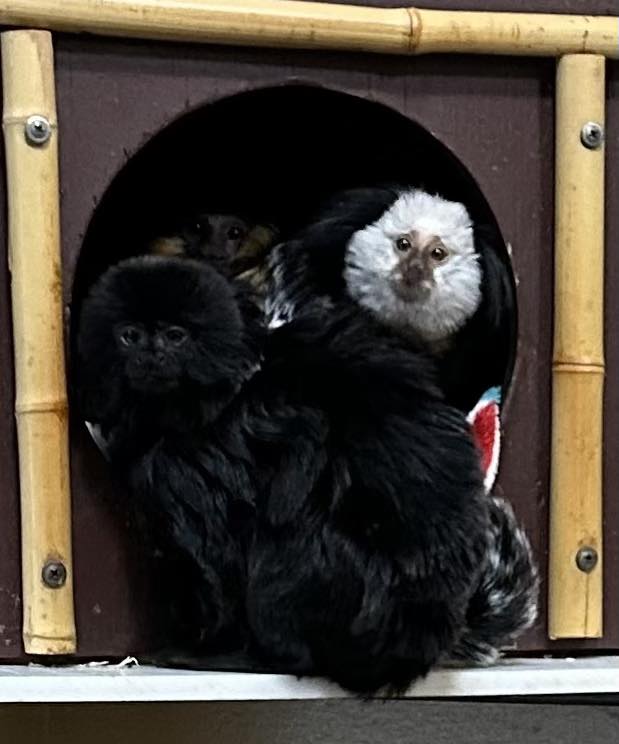- The significance of mixed-species exhibits in zoos and their role in conservation efforts.
- Characteristics and behaviors of callitrichids, focusing on Goeldi’s Monkey, White-Fronted Marmoset, and the Golden-Headed Lion Tamarin.
- Social dynamics and behavioral interactions between different callitrichid species within the exhibit.
- Educational value and visitor engagement opportunities provided by the new exhibit.
- Conservation challenges facing callitrichids and how zoos contribute to their preservation.
Zoos are continually evolving to better serve the needs of the animals and the public, striving not just for entertainment, but also for conservation and education. The introduction of mixed-species exhibits represents a pivotal approach in zoo management, enhancing animal welfare, enriching the visitor experience, and initiating imperative conservation dialogues. By juxtaposing different species within a shared habitat, zoos mimic the intricate ecological networks found in the wild, offering a richer, more dynamic environment for the animals and a unique viewing experience for the public.
Within this exciting new mixed-species exhibit, we find a combination of magnificent primates from the callitrichid family: Picchu the Goeldi’s Monkey, Huey the White-Fronted Marmoset, and Cliff the Golden-Headed Lion Tamarin. These small primates are native to the dense tropical forests of South America and are known for their social structures and cooperative behaviors. The mixed-species setting allows these animals to demonstrate an array of natural behaviors that single-species exhibits cannot emulate. It provides a more holistic view of the animals’ lives and their capabilities in navigating a complex habitat.
The mixed-species exhibit at the zoo serves multiple purposes. Firstly, it aims to create a captivity setting that closely resembles the animals’ natural ecosystems. This approach not only improves their quality of life but also serves as a key component in behavioral research. Callitrichids, including Goeldi’s Monkeys, White-Fronted Marmosets, and Golden-Headed Lion Tamarins, exhibit fascinating interactions. Goeldi’s Monkeys, for instance, are known for their curiosity and ability to use tools, a rare trait among primates of their size. Meanwhile, White-Fronted Marmosets are recognized for their intricate vocal communications. The presence of these three species within a unified habitat spurs each to naturally exhibit behaviors beneficial to their mutual understanding and cooperation.
The social dynamics within this environment are complex yet understandable. Callitrichids are highly social animals, living in family groups with strict social hierarchies and roles. This makes the mixed-species setup especially intriguing. Observing Picchu, Huey, and Cliff as they interact opens a window into their world, highlighting how environmental and social influences shape behaviors. For instance, cooperative feeding and grooming not only help establish social bonds but also maintain group cohesion and harmony. This environment encourages play, another critical component of their socialization. Play among callitrichids builds physical skills, reinforces social ties, and reduces tension, helping these animals thrive both physically and mentally.
Educationally, mixed-species exhibits provide a vivid tableau for learning. As visitors traverse the exhibit, they witness firsthand the complex social structures and interactive behaviors of callitrichids. The educational programs and keeper talks are instrumental in enhancing understanding. By focusing on topics such as animal behavior, their role in the ecosystem, and ongoing conservation efforts, these programs inspire respect and a sense of stewardship for the environment among visitors of all ages. The interactive nature of the exhibit, punctuated by scheduled feeding and enrichment activities, keeps the audience engaged, fostering a deeper connection with the animals on display.
This exhibit is not only about showcasing diversity but also about addressing the conservation challenges facing callitrichids. Habitat destruction, climate change, and illegal wildlife trade threaten their survival in the wild. Zoos play a critical role in combating these threats through breeding programs, habitat restoration projects, and educational outreach. The collaboration between zoos, conservation organizations, and governments is crucial for the preservation of these species. The mixed-species exhibit highlights the need for such cooperation, illustrating how combined efforts can lead to successful conservation outcomes.
In conclusion, the new mixed-species exhibit at the zoo is an exciting development, embodying both conservation and education. By highlighting the social dynamics and unique characteristics of callitrichids, the exhibit offers a profound educational experience. It reinforces the role of zoos in conserving biodiversity and inspires action towards protecting these remarkable animals. The exhibit is open Friday to Sunday, 1:00-5:00 PM, providing ample opportunity to observe and learn from these fascinating primates. As visitors explore, they gain not only an appreciation for the animals but also a deeper understanding of the complexities of wildlife conservation. By bridging the gap between educational entertainment and conservation awareness, the zoo continues to pave the path toward a sustainable future for wildlife and the planet.
*****
Source Description
Exciting news from the zoo! We’ve combined a variety of callitrichids (primate family) into a vibrant, mixed-species exhibit! (Here you see Picchu (the Goeldi’s Monkey), Huey (White Fronted Marmoset), and just barely peeking out from behind, Cliff (the Golden Headed Lion Tamarin)!
These small, social primates are now living together, showcasing their unique behaviors and interactions. It’s fascinating to watch them cooperate, play, and thrive in their new shared space! Come see the fun for yourself and learn more about these amazing creatures. Open Friday-Sunday, 1:00-5:00pm.
📸Keeper Emily


